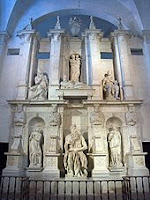 |
| Madonna of the Stairs |
 |
| Battle of the Centaurs |
According to Condivi, Lorenzo di pierfrancesco de' Medici, for whom Michelangelo had sculpted St. John the Baptist, asked that Michelangelo "fix it so that it looked as if it had been buried" so he could "send it to Rome…pass [it off as] an ancient work and…sell it much better." Cardinal Raffaele Riario, discovered that it was a fraud, but was so impressed by the quality of the sculpture that he invited the artist to Rome. This apparent success in selling his work encouraged Michelangelo to accept the prelate's invitation. He was 21 yrs old and already an artist of significant if somewhat questionable repute.
His fame was to grow, in Rome where he completed what is likely one of his most famous sculptures. The Peita, a depiction of Christ in the Lap of his Mother following the crucifiction. he was just 24 yrs old. 5 yrs later he completed the David.
 |
| Peita |
In 1505 Michelangelo was invited back to Rome by the newly elected Pope JuliusII He was commissioned to build the Popes tomb. Under the patronage of the Pope, Michelangelo had to frequently stop work on the tomb to accomplish numerous other tasks. Because of this, Michelangelo worked on the tomb for 40 years. The tomb,was never finished to Michelangelo's satisfaction. It is located in the Church of S. Pietro in Vincoli in Rome.
During the same period, Michelangelo took the commission to paint the ceiling of the Sistine Chapel, which took approximately four years to complete (1508–1512). According to Michelangelo's account,Bramante and Raphael convinced the Pope to commission Michelangelo in a medium not familiar to the artist.It is said, This was done in order that he, Michelangelo, would suffer unfavorable comparisons with his rival Raphael.
Michelangelo was originally commissioned to paint the 12 Apostles against a starry sky, but lobbied for a different scheme, representing creation, the Downfall of Man and the Promise of Salvation. The work is part of a larger scheme of decoration within the chapel.
The work would eventually contain over 300 figures and had at its center nine episodes from the book of Genesis, divided into three groups: God's Creation of the Earth; God's Creation of Humankind and their fall from God's grace; and lastly, the state of Humanity. On the pendentives supporting the ceiling are painted twelve men and women who prophesied the coming of the Jesus.
His last work in the chapel would be the last Judgement on the Altar wall of the Sistine Chapel. This work would draw immese censorship from within the church, but the pope supported Michealangelos interpretation.and the work remained uncensored until after his death.
The infamous "fig-leaf campaign" of the counter Reformation, aiming to cover all representations of human genitals in paintings and sculptures, started with Michelangelo's work. Many of his sculptures were covered by added drapery, many remained covered for several decades. Also, the plaster copy of the David in the Victoria and Albert Museum in London, had a fig leaf in a box at the back of the statue. It was there to be placed over the statue's genitals so that they would not upset visiting female royalty.
In 1546, Michelangelo was appointed architect of St Peters Basillica in the Vatican, and designed its dome. As St. Peter's was progressing there was concern that Michelangelo would pass away before the dome was finished. However, once building commenced on the lower part of the dome, the supporting ring, the completion of the design was inevitable. Michelangelo died in Rome at the age of 88 His body was brought back from Rome for Burial at the Basilica di Santa Croce, He was to keep illustrous company there, along side Galileo, Machiavelli, Rossini, Foscolo and Gentile. Fulfilling his last request to be buried in his beloved Tuscany.
A smidgen of Art History ....



No comments:
Post a Comment